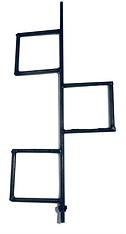
CompostPro
OVERVIEW
Sponsor
Vermont Composting Systems, LLC
My Role
IP
Team Members
Mechanical Engineer
Design Researcher
Patent Pending
Sam Albertsen
Sharon Bian
Seamore Zhu
PROBLEM
Although composting food can help reduce human-related methane emissions, the process is labor intensive, smelly, and inconvenient. CompostPro eases the burden for homeowners by automatically maintaining optimal conditions for compost.
Today's state-of-the-art home composting systems require regular maintenance and background knowledge, making home composting too high-effort for homeowners.

CompostPro
Giving homeowners a pathway to a sustainable lifestyle by making composting convenient and accessible.
CompostPro is a fully integrated system with 4 major components that automatically maintains compost from start to finish for homeowners. The core component of the system is the mixing chamber. Food is inputted through the top and stored in the tank, which is located outside the home.
Motor Assembly
Low speed, high torque motor assembly drives an internal steel crankshaft that mixes compost to distribute heat and oxygen.
Hatch
Hatch at base of tank allows user to access fully mature compost.

Tank
30 gallon tank is sized for the food waste output of a family of 4, also accounting for carbon input and food waste shrinkage. The height of the tank paired with the crankshaft mixer stratifies
compost by age.
Mesh & Tank Stand
Radial cutouts and steel mesh in base of tank allows excess water to drain out. The tank is elevated so a container can be placed underneath to collect the compost tea.
Additional Components

Filter
New food waste is compressed to filter out excess water, preventing anaerobic decomposition and reducing odors.

Carbon Input
User collects and stores brown matter in an adjacent tank, which automatically deposits it to maintain the 30:1 carbon-nitrogen ratio.

Control System
Electronics system automates compost maintenance, making it less labor intensive and more convenient.
Our solution to this imminent problem turns food scraps into "black gold" and addresses top user complaints. By increasing the popularity of composting, our system will work to reduce greenhouse gas emissions and cycle nutrients back into the soil system.
Impact
PROCESS
User Research
We began approaching the problem by researching state-of-the-art compost systems and interviewing expert composters. Our team also started collecting our own food scraps to get first-hand experience in maintaining compost.
Following our initial research, we conducted 40 interviews with current composters and non-composters. Synthesizing this data led to identifying major user complaints about home composting and our target audience, which was middle class homeowners in the Upper Valley. We also learned about the Vermont Universal Recycling Law, which banned food waste from landfills starting July 1, 2020.

Top user complaints and proposed solutions

CompostPro fills a gap in the market
Prototyping
We looked for inspiration in existing solid mixing mechanisms that could be applied to composting. Our mixer prototypes included an auger, a tumbler, crankshaft, and helical mixer. We used compost sourced from the Dartmouth Organic Farm for testing. We ultimately selected the crankshaft due to its effective mixing and stratification, and its ease of manufacturing.

Fabrication
We utilized the Thayer Machine Shop to manufacture our final proof-of-concept for our client. Processes used include laser cutting, MIG welding, milling, and lathing.



Testing & Analysis
We performed 3 major tests on the mixing chamber to evaluate its performance:
1. Test efficacy of steel crankshaft for mixing and stratification.
2. Test power consumption of motor.
3. Test displacement of crankshaft and motor assembly under load using FEA.

Mixing and stratification test results

Power test results

FEA and displacement
